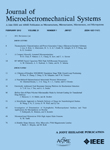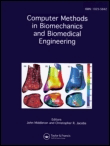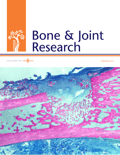
PROCEEDINGS OF THE INSTITUTION OF MECHANICAL ENGINEERS PART H-JOURNAL OF ENGINEERING IN MEDICINE
Scope & Guideline
Empowering Healthcare: The Intersection of Engineering and Medicine
Introduction
Aims and Scopes
- Biomechanical Engineering:
Research in this area focuses on understanding the mechanical behavior of biological tissues and systems, including studies on joint mechanics, implant interactions, and the effects of various forces on human anatomy. - Medical Device Development:
This scope encompasses the design, testing, and optimization of medical devices, including prosthetics, implants, and surgical instruments, often integrating advanced materials and manufacturing techniques. - Computational Modeling and Simulation:
The journal frequently publishes studies utilizing computational methods for simulating biological processes, predicting outcomes of surgical interventions, and analyzing the mechanical properties of tissues and implants. - Rehabilitation Engineering:
Research addressing the design and effectiveness of assistive technologies, including robotics and exoskeletons, aimed at enhancing recovery and improving the quality of life for individuals with disabilities. - Artificial Intelligence in Medicine:
The integration of AI and machine learning techniques for diagnostics, predictive modeling, and personalized medicine is a growing focus of research, highlighting innovative approaches to healthcare challenges.
Trending and Emerging
- Wearable Health Technologies:
There is a growing emphasis on the development and application of wearable devices that monitor health metrics, providing real-time data for patient management and enhancing personalized healthcare. - Machine Learning and AI Applications:
Research incorporating machine learning algorithms to improve diagnostic accuracy and treatment outcomes is increasingly prevalent, showcasing the potential of AI to revolutionize medical practices. - 3D Printing in Medicine:
The application of 3D printing technologies for creating customized implants, prosthetics, and biological scaffolds is becoming a key area of focus, reflecting the shift towards personalized medicine. - Telemedicine and Remote Monitoring:
The rise of telemedicine, particularly accelerated by the COVID-19 pandemic, has led to increased research on remote monitoring systems and their implementation in clinical settings. - Biomaterials Development:
Innovations in biomaterials, particularly those that enhance biocompatibility and functionality for implants and tissue engineering applications, are seeing a surge in research interest.
Declining or Waning
- Traditional Surgical Techniques:
There has been a noticeable decrease in studies focusing on conventional surgical methods as newer, less invasive techniques and technologies gain traction in clinical practice. - Static Biomechanical Models:
Research relying heavily on static models for biomechanical analysis is waning, with a shift towards dynamic modeling that better represents real-life conditions and interactions. - Non-computational Experimental Studies:
There is a decline in purely experimental studies that do not incorporate computational analysis, as interdisciplinary approaches combining both methods are increasingly favored for their comprehensive insights. - Generalized Medical Device Testing:
Research that does not focus on specific, innovative applications of medical devices is becoming less frequent, indicating a trend towards more targeted studies that address specific medical needs or technological advancements.
Similar Journals

Acta Mechanica et Automatica
Elevating Knowledge in Mechanical Engineering and AutomationActa Mechanica et Automatica is a leading open-access journal published by SCIENDO, dedicated to the dynamic fields of Mechanical Engineering and Control and Systems Engineering. Since its inception in 2012, this journal has provided a vital platform for researchers and professionals to disseminate innovative findings and advances within these disciplines, boasting a convergence of years up to 2024. Based in Warsaw, Poland, the journal has embraced open access since 2013, ensuring broad dissemination of knowledge for the academic community globally. With a current Scopus ranking placing it in the 25th to 31st percentile among its peers, it plays an essential role in fostering scholarly communication and collaboration. The objectives of Acta Mechanica et Automatica include promoting original research, facilitating dialogue between disciplines, and enhancing the understanding of complex mechanical and control systems. This journal is invaluable for researchers looking to explore cutting-edge methodologies, theories, and applications in engineering.

Network Modeling and Analysis in Health Informatics and Bioinformatics
Exploring the future of health informatics through network analysis.Network Modeling and Analysis in Health Informatics and Bioinformatics, published by SPRINGER WIEN, stands as a vital resource in the interdisciplinary domains of health informatics and bioinformatics. With an ISSN of 2192-6662 and E-ISSN of 2192-6670, this journal aims to facilitate the dissemination of innovative research that intersects network modeling, data analysis, and health applications. The journal competes at a Q3 quartile level across multiple categories including Biomedical Engineering and Health Informatics, showcasing its growing influence within the academic community. As of 2023, it holds impressive Scopus rankings, including a 20th position in Urology, illustrating its significance in the field. Although not an open access publication, the journal is dedicated to providing cutting-edge insights from 2012 to 2024 and is poised to attract researchers, professionals, and students striving to push the boundaries of knowledge in health informatics and bioinformatics. This journal is not just a platform for sharing scholarly articles; it is a catalyst for advancing methodologies that enhance patient care and medical research.

ANNALS OF BIOMEDICAL ENGINEERING
Innovating at the intersection of technology and healthcare.ANNALS OF BIOMEDICAL ENGINEERING is a premier journal in the field of biomedical engineering, published by Springer. Established in 1972, this journal has become a vital resource for researchers, professionals, and students engaged in the rapidly evolving domain of biomedical technology. With a commendable impact factor and ranked in the 76th percentile among its peers as per Scopus, it exemplifies excellence in disseminating critical research findings. The journal covers a broad scope of topics related to the integration of engineering principles with medical and biological sciences, facilitating innovations that enhance healthcare outcomes. Although open access is not offered in this journal, it remains an essential platform for scholarly communication, contributing to the continuous advancement of knowledge in biomedical engineering. ANNALS OF BIOMEDICAL ENGINEERING is not only a bridge for academics to share groundbreaking research but also an influential guide for practical applications in medicine and health technologies, making it a fundamental publication for its readership.

JOURNAL OF MICROELECTROMECHANICAL SYSTEMS
Elevating Research Standards in MEMS ApplicationsThe JOURNAL OF MICROELECTROMECHANICAL SYSTEMS, published by the IEEE-Institute of Electrical and Electronics Engineers Inc, stands as a pivotal resource in the fields of Electrical and Electronic Engineering as well as Mechanical Engineering. With an ISSN of 1057-7157 and an E-ISSN of 1941-0158, this esteemed journal has been at the forefront of advancing microelectromechanical technology since its inception in 1992. As evidenced by its impressive Scopus rankings, holding a Q2 position in Electrical and Electronic Engineering and a Q1 status in Mechanical Engineering, the journal serves as a conduit for high-quality research and innovative applications in the microelectromechanical systems domain. Notably, it is well-regarded yet accessible, making it an essential resource for researchers, professionals, and students alike, who are eager to contribute to or stay informed on the latest advancements. Published in the United States, the journal covers a broad array of topics within its scope, ensuring a comprehensive overview of emerging trends and technologies. It remains dedicated to fostering scholarly communication and innovation in this rapidly evolving field.

COMPUTER METHODS IN BIOMECHANICS AND BIOMEDICAL ENGINEERING
Innovating Computational Techniques for Medical BreakthroughsCOMPUTER METHODS IN BIOMECHANICS AND BIOMEDICAL ENGINEERING, published by TAYLOR & FRANCIS LTD, is a leading journal dedicated to the interdisciplinary field of biomechanics and biomedical engineering. With an ISSN of 1025-5842 and an E-ISSN of 1476-8259, this journal has been a significant resource since its inception in 1997 and will continue to publish cutting-edge research until 2024. The journal holds a respectable position in the academic community, categorized in Q3 of multiple domains including Bioengineering, Biomedical Engineering, and Human-Computer Interaction, reflecting its relevance across diverse fields. Although the journal does not offer open access, it provides valuable insights and methodologies essential for researchers, professionals, and students engaged in advancing computational techniques and their application in medicine and engineering. With Scopus rankings highlighting its growing influence, particularly in the Biomedical Engineering and Human-Computer Interaction sectors, this journal plays a crucial role in fostering innovation and enhancing the understanding of biomechanical systems through computational methods.

Biomaterials and Biomechanics in Bioengineering
Advancing the Future of Bioengineering.Biomaterials and Biomechanics in Bioengineering is a premier peer-reviewed journal dedicated to the exploration of innovative advancements in the field of bioengineering. Published by TECHNO-PRESS, the journal aims to bridge the gap between biomaterials science and biomechanics, providing a platform for researchers, practitioners, and students to disseminate their findings. With a focus on the latest developments in material design, mechanical behavior, and their applications in medical devices and tissue engineering, Biomaterials and Biomechanics in Bioengineering plays a crucial role in fostering interdisciplinary collaboration and innovation. This journal not only encourages open access to cutting-edge research but also seeks to influence the global bioengineering community through its rigorous publication standards and emphasis on practical applications. Stay at the forefront of bioengineering research and contribute to the discourse shaping the future of healthcare technologies.

Engineering Journal-Thailand
Elevating research excellence in the heart of Thailand.Engineering Journal-Thailand, published by Chulalongkorn University, Faculty of Engineering, is a prominent academic journal dedicated to advancing knowledge and research in the diverse field of engineering. With an ISSN of 0125-8281 and an unwavering commitment to quality, the journal has established a substantial presence in the academic community since its inception in 2009. As of 2023, it is ranked in the Q3 category for Engineering (miscellaneous) and has achieved a Scopus rank of 137 out of 307, placing it in the 55th percentile of general engineering journals. Although it operates without open access, its impact within the engineering domain is significant, providing a vital platform for researchers, professionals, and students to disseminate their findings and engage with contemporary engineering challenges. The journal serves as a vital resource for those seeking to stay at the forefront of engineering innovation and contributes to the global discourse by bridging local insights with international perspectives.

Applied Bionics and Biomechanics
Advancing Biomechanical Solutions through Interdisciplinary ResearchApplied Bionics and Biomechanics, published by HINDAWI LTD, is a leading open-access journal dedicated to the interdisciplinary integration of biological and engineering principles, particularly within the realms of bioengineering, biomedical engineering, and biotechnology. With an ISSN of 1176-2322 and E-ISSN of 1754-2103, the journal operates out of the United Kingdom since its inception in 2003, providing a vital platform for the dissemination of innovative research and practical applications that enhance our understanding of biomechanical systems. Although the journal's coverage was discontinued in Scopus after 2023, it remains a valuable resource for researchers, professionals, and students, highlighted by its Q3 ranking across multiple categories, underlining its respectable position within the academic community. The journal encourages open sharing of ideas, fostering collaboration among diverse scientific fields, with the objective of addressing complex challenges in the interface of biology and engineering.

Acta of Bioengineering and Biomechanics
Nurturing academic inquiry to drive breakthroughs in biomaterials and biophysics.Acta of Bioengineering and Biomechanics is a distinguished academic journal published by Wroclaw University of Technology, Faculty of Computer Science & Management, focusing on the interdisciplinary fields of bioengineering and biomechanics. Since its inception in 2005, the journal has provided a platform for innovative research and critical reviews that contribute to the advancement of knowledge in areas such as biomaterials, biomedical engineering, and biophysics. Despite its current Q4 ranking in several categories, including Bioengineering and Biomaterials, it serves as a valuable resource for emerging scholars and seasoned professionals alike, highlighting the evolving landscape of research in these dynamic fields. The journal brings together a diverse range of studies, fostering collaboration and creativity among its readership. With its commitment to disseminating high-quality research, Acta of Bioengineering and Biomechanics plays an essential role in nurturing academic inquiry and professional growth within the scientific community in Poland and beyond.

Bone & Joint Research
Exploring the frontiers of bone and joint health.Bone & Joint Research is a prestigious open access journal published by the British Editorial Society of Bone & Joint Surgery, which has been serving the orthopedic and surgical community since its inception in 2012. With an impact factor reflecting its high standards and relevance within the field, this journal boasts impressive Scopus rankings, positioning it in the Q1 category for both Orthopedics and Sports Medicine and Surgery as of 2023. Located in the United Kingdom, the journal aims to disseminate cutting-edge research, clinical studies, and innovative approaches to treatment in musculoskeletal health, making it an indispensable resource for researchers, healthcare professionals, and students alike. The journal encourages a collaborative discourse that fosters advancements in the understanding and treatment of bone and joint diseases, fulfilling its mission to enhance patient outcomes and improve the quality of care.